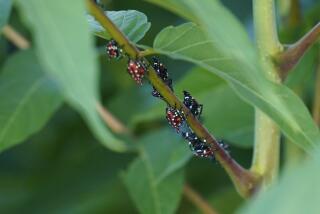On guard against a sticky problem
- Share via
ALBUQUERQUE, N.M. — As the temperatures rise and nature gears up for spring, federal biologists in the United States and Mexico are rolling out a plan to keep a menacing bug from making its way farther west.
The objective: Seek out and destroy the cactus moth.
At stake: The flat-leafed prickly pear cactus that has become synonymous with the Southwest and has grown into a $100-million industry in Mexico, which uses the tart fruit and tender pads for food.
Biologists recently confirmed that moths caught in a trap in the resort town of Cancun were of the dreaded Cactoblastis cactorum variety. This is the first time the moths have been found on the mainland.
The moths, while in their caterpillar form, bore into the cactus pads and feed, turning the plant into a gooey, oozing mess.
“We’re trying to raise awareness,” said Joel Floyd, who works with the U.S. Department of Agriculture’s Plant Protection and Quarantine Division. “The best thing is really early detection. If you spot it early, you have a better chance of controlling it.”
Part of the battle plan includes setting survey traps in several states, including New Mexico; releasing sterile moths to slow reproduction; and getting the word out to people like Albuquerque resident Penny Hoe.
Hoe and her husband, Gary, are members of the Cactus and Succulent Society of New Mexico. Their prickly passion is evident by their yard -- a prickly pear orchard that yields fruit and pads for salsa and jelly, and even sherbet.
Even though the cactus moth is still far from New Mexico, Hoe can serve as an unofficial foot soldier for the USDA, keeping watch for nonnative pests as she tends her orchard.
“The one thing I’m worried about if those moths get here, other than not having juice to cook with, is the bees, the pollinators,” she said.
Not to mention the ground squirrels, coyotes and rabbits that feed on the plants when rain is scarce, as it often is in the desert.
The cactus moth, a native of South America, was introduced in Australia in the 1920s as a way to get rid of non-native prickly pear. It did such a good job that its services were used in South Africa, and it eventually spread to the Caribbean.
From there, it was a hop-skip to the Florida Keys, then to Alabama, Georgia and South Carolina. Then the moth started blazing a trail in the South. It was moving so fast that the USDA predicted it would find its way to Texas by this year.
But the advance has slowed over the last two years, and Floyd said researchers have had more time to study it.
The USDA has released sterile moths on Dauphin Island, Ala., which is the western front of known populations of Cactoblastis cactorum in the United States. The idea is to flood the population with sterile moths, reducing reproduction.
Floyd said the fight against Cactoblastis will be funded by the U.S. and Mexican governments, each contributing about $500,000 this year. That money will go toward more laboratory research and sterile releases as well as surveying in New Mexico and other states.
Whether the cactus moth will gain a foothold in Mexico or find its way to the Southwest is anybody’s guess.
“I don’t know for sure,” said Dave Ferguson, a curator at the Albuquerque Botanical Garden. “I don’t think anyone knows for sure, but I suspect it won’t take the cold, dry climate here.”
Ferguson notes that New Mexico and other parts of the Southwest have other pests that prey on prickly pears, including a native version of the cactus moth.
“There are years when they’re really bad and they hollow out a lot of the native prickly pears,” he said. “Four or five years ago, they were really bad up around Durango [Colorado]. You could swear that all the prickly pears were doing to die, but you go back up there now and they’ve come back pretty well.”
More to Read
Sign up for Essential California
The most important California stories and recommendations in your inbox every morning.
You may occasionally receive promotional content from the Los Angeles Times.













